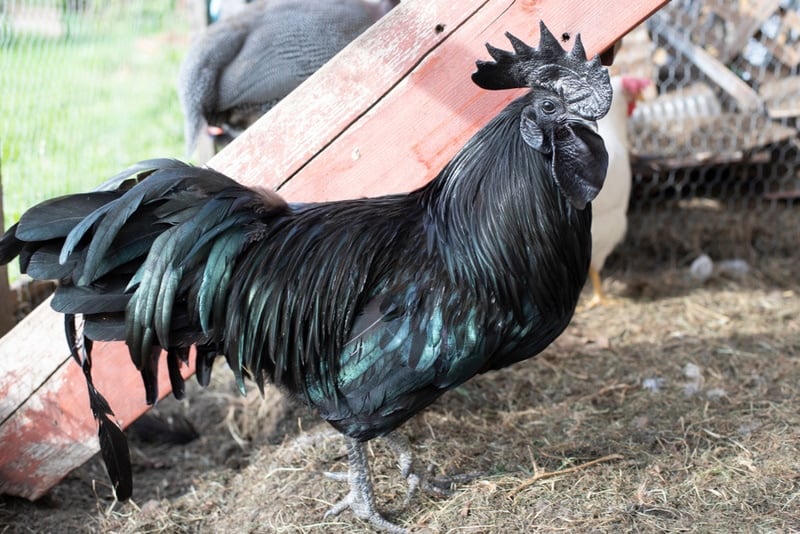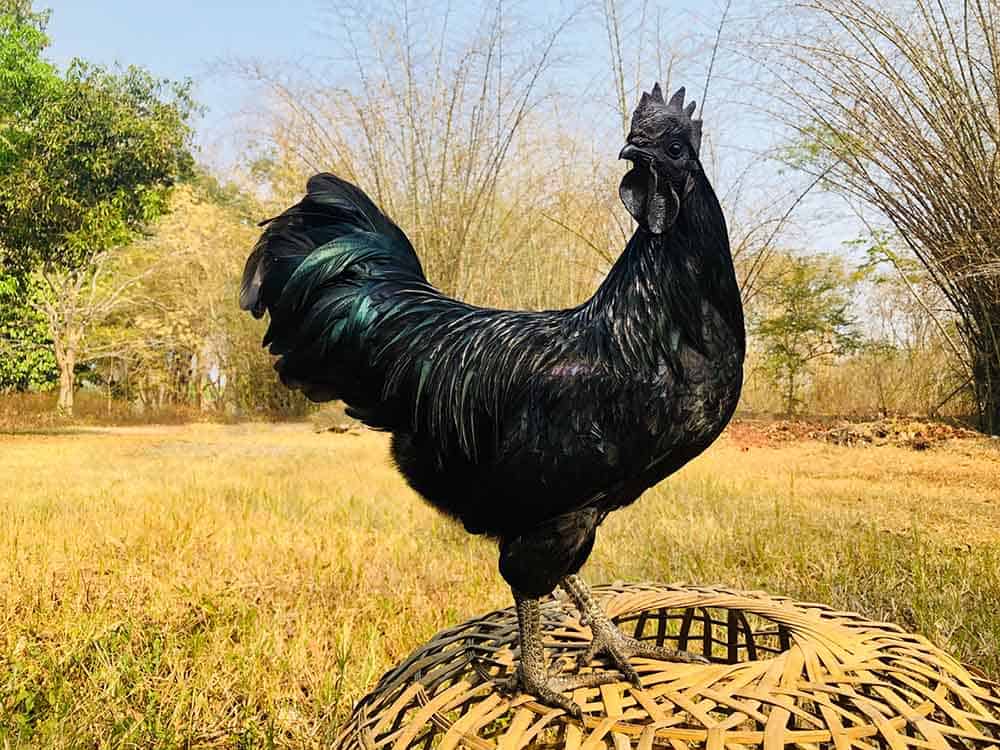The Ayam Cemani will stun any onlooker with its unique appearance. When we say they are completely black, we don’t mean like an Australorp—even their combs and wattles are totally black! All coal-black, this chicken is a rare sight to behold—very uncommon in most cases.
While they might be nearly impossible to obtain for your own flock, you can appreciate this gorgeous poultry breed. As they grow in popularity through Fancier’s Associations, you might be able to get your hand on one, though it often requires waiting lists.

Quick Facts About Ayam Cemani Chickens
| Breed Name: | Ayam Cemani |
| Place of Origin: | Indonesia |
| Uses: | Ornamental |
| Rooster Size: | 6-6.5 pounds |
| Hen Size: | 3.5-5 pounds |
| Color: | Solid black |
| Lifespan: | 6-8 years |
| Climate Tolerance: | Hardy |
| Care Level: | Moderate |
| Production: | Low |
| Temperament: | Active, low maintenance |
Ayam Cemani Origins
The Ayam Cemani spawned from the Java island of Indonesia in the 12th century. The bird was originally used for mystical or religious purposes but no longer resides in the country today.
Because of their intriguing appearance, these chickens were imported to Europe in 1998, starting with Dutch settler Jan Steverink.

Ayam Cemani Characteristics
Ayam Cemani chickens have game bird roots, but that doesn’t seem to reflect in their personalities. These birds tend to be pretty even-keeled and low-maintenance.
This breed is very confident without being flighty or hard to handle. They tend to coexist peacefully along with a flock and forage fantastically well for themselves.
Roosters might have some aggressive tendencies, but they are overall easy to manage.
Uses
Since Ayam Cemani is a rare breed, raising them for meat is not advised. Since it’s such a gamble on whether owning a chick is a possibility, it’s best for ornamental use.
The Ayam Cemani is a very poor layer and is sporadic in their schedule. They can lay semi-regularly and then stop completely for months at a time. So, you can’t count on them for any real purpose. But we think you’ll agree that the unique appearance makes up for the lack of utility.
Ayam Cemani eggs tend to be large in comparison to their size. They are usually pale cream with a slightly pink hue. In total, they only lay roughly 69 to 100 eggs per year in sporadic intervals.
Any claims of black egg laying are false—no chicken breed lays black eggs—not even the Ayam Cemani.
While it seems to be a 50/50 shot whether your hens go broody, they tend to make excellent mothers when they do. If you plan on trying to raise an Ayam Cemani from eggs, another broodier hen might do the job.

Appearance & Varieties
The one trademark quality of the Ayam Cemani is that both the roosters and hens are entirely black. They have an iridescent hue to their feathering, making them shine brilliantly in the sun.
Both roosters and hens are heavy bodied with muscular, lean tone. They reach weights of up to 7 pounds while females generally stay below 5 pounds. Males outweigh females and have tall, cascading tail feathers—creating quite a presence.
This breed is not bantam size—it is a standalone standard chicken breed.

Population/Distribution/Habitat
If you’re interested in the Ayam Cemani, where do you buy it? Let’s learn a little more about overall availability and how to keep your flock.
Population
Unfortunately, there are very few Ayam Cemanis in the world. In the USA, their numbers are so low that private breeders are often booked a year or more in advance for chicks.
There are an estimated 3.500 Ayam Cemani chickens worldwide and they continue to be one of the rarest breeds.
Distribution
- Netherlands
- Sweden
- Italy
- Belgium
- Germany
- Czech Republic
There is an Ayam Cemani Association in the United States. There are also several Fanciers Associations on social media. There is likely a waiting list, some of which can be several years long, to obtain a check.
Because of lack of availability, you might be unable to choose whether you want a male or female.
Habitat
Because of the rarity of these birds, free ranging is often a bad idea. These birds are too susceptible to predators, so having an enclosure or movable coop is probably best.
These guys love to be active, so make sure they have plenty of space to forage and explore. Always remember to supplement with commercial grain and provide a freshwater source.

Are Ayam Cemani Good for Small-Scale Farming?
The Ayam Cemani is a scarce chicken breed, and it’s unlikely that you will get the opportunity. However, if you do, you might work to multiply the breed. Many Ayam Cemani lovers work hard to preserve the breed—and with a little work, you can be among them.
However, these chickens are not the type you’ll see at a local hatchery without some serious special ordering. So, if you really want to get your hands on Ayam Cemani chicks, check breeders in your area.
Featured Image Credit: Bass001, Shutterstock
